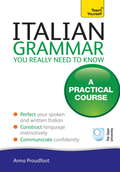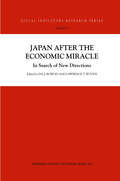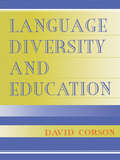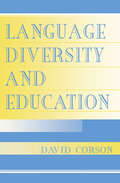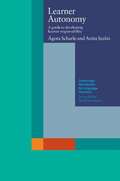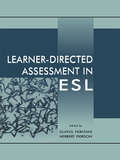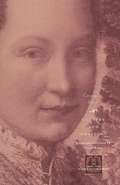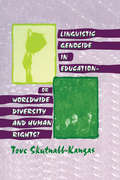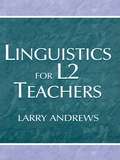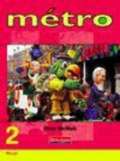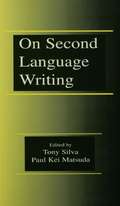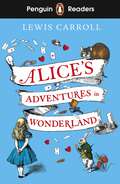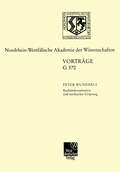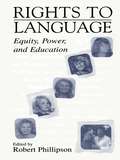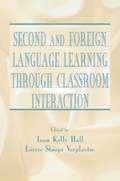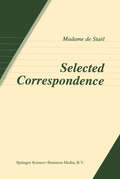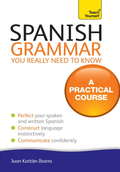- Table View
- List View
Italian Grammar You Really Need to Know: Teach Yourself (Teach Yourself Language Reference)
by Anna ProudfootComprehensive and clear explanations of key grammar patterns and structures are reinforced and contextualized through authentic materials. You will not only learn how to construct grammar correctly, but when and where to use it so you sound natural and appropriate. "Italian Grammar You Really Need to Know will help you gain the intuition you need to become a confident communicator in your new language.
Japan after the Economic Miracle: In Search of New Directions (Social Indicators Research Series #3)
by Paul Bowles and Lawrence T. WoodsAs Japan comes to grips with a decade of economic malaise after its spectacular post-war growth record, how will Japanese society react? Contributors to this volume examine the challenges ahead for Japan in the fields of politics, economics, sociology, environment and business. This multidisciplinary inquiry looks for areas of continuity and for new directions in government, business and social policy and practice. Also examined is how Western students should approach the study of Japan; what new directions should institutions take to ensure that students learn about the `real' Japan? Written by Canadian academics, the articles in this volume will be of interest to academics and policy-makers studying or teaching about contemporary Japan.
Language Diversity and Education
by David CorsonThis introductory text for students of linguistics, language, and education provides background and up-to-date information and resources that beginning researchers need for studying language diversity and education. Three framing chapters offer an update on the philosophy of social research, revealing how important language is for all the processes of learning in which humans engage, whether it is learning about the world through education, or learning about the nature of social life through research in the human sciences. These chapters also review the links between language, power, and social justice, and look at dynamic changes occurring in "language diversity and education" research. Four central chapters give state-of-the-art, comprehensive coverage to the chief areas of language diversity that affect the practice of education: standard and non-standard varieties; different cultural discourse norms; bilingual and ESL education; and gendered discourse norms. This book is intended for graduate students of applied linguistics, sociolinguistics, psycholinguistics, the social psychology of language, anthropological linguistics, and other related disciplines; and graduate students of education, including in-service teachers taking advanced professional development courses. Special features enhance its usefulness as a text for courses in these areas: * A clear, jargon free writing style invites careful reading. * All ideas are well within the range that graduate students in the language disciplines or in education can relate to their work, but theoretical ideas are kept to a necessary minimum and linked with practical examples in every case. * Extensive references guide readers to the book's up-to-date, international, and cross-cultural bibliography. * "Discussion Starter" questions at the end of each chapter highlight key points and stimulate informed, reflective discussion.
Language Diversity and Education
by David CorsonThis introductory text for students of linguistics, language, and education provides background and up-to-date information and resources that beginning researchers need for studying language diversity and education. Three framing chapters offer an update on the philosophy of social research, revealing how important language is for all the processes of learning in which humans engage, whether it is learning about the world through education, or learning about the nature of social life through research in the human sciences. These chapters also review the links between language, power, and social justice, and look at dynamic changes occurring in "language diversity and education" research. Four central chapters give state-of-the-art, comprehensive coverage to the chief areas of language diversity that affect the practice of education: standard and non-standard varieties; different cultural discourse norms; bilingual and ESL education; and gendered discourse norms. This book is intended for graduate students of applied linguistics, sociolinguistics, psycholinguistics, the social psychology of language, anthropological linguistics, and other related disciplines; and graduate students of education, including in-service teachers taking advanced professional development courses. Special features enhance its usefulness as a text for courses in these areas: * A clear, jargon free writing style invites careful reading. * All ideas are well within the range that graduate students in the language disciplines or in education can relate to their work, but theoretical ideas are kept to a necessary minimum and linked with practical examples in every case. * Extensive references guide readers to the book's up-to-date, international, and cross-cultural bibliography. * "Discussion Starter" questions at the end of each chapter highlight key points and stimulate informed, reflective discussion.
Learner Autonomy: A Guide to Developing Learner Responsibility (PDF) (Cambridge Handbooks For Language Teachers Ser.)
by Agota ScharleLearner Autonomy offers practical guidance on helping learners realise that their contribution to the teaching-learning process is crucial. It also encourages them to take an active role in their own learning. Rather than advocating radical changes in Classroom Management, it focuses on the gradual process of changing learner attitudes. The activities are designed to develop a comprehensive range of skills and attitudes including motivation, learning strategies, self-monitoring and co-operation. The activities can be easily integrated into the regular curriculum as almost all serve some linguistic purpose in addition to learner development.
Learner-directed Assessment in Esl
by Glayol V. Ekbatani Herbert D. PiersonThis text integrates the theory and practice of learner-based assessment. Written in response to two recent movements in language teaching--learner-centered teaching and a renewed interest in authenticity in language testing--it examines the relationship between the language learner and language assessment processes, and promotes approaches to assessment that involve the learner in the testing process. Particular attention is given to issues of reliability and validity. Grounded in current pedagogical applications of authentic assessment measures, this volume is intended for and eminently accessible to classroom teachers and program directors looking for ways to include their students in the evaluation process, graduate students, and professional language testers seeking authenticity in assessment and desiring to create more interactive evaluation tools.
Learner-directed Assessment in Esl
by Glayol V. Ekbatani Herbert D. PiersonThis text integrates the theory and practice of learner-based assessment. Written in response to two recent movements in language teaching--learner-centered teaching and a renewed interest in authenticity in language testing--it examines the relationship between the language learner and language assessment processes, and promotes approaches to assessment that involve the learner in the testing process. Particular attention is given to issues of reliability and validity. Grounded in current pedagogical applications of authentic assessment measures, this volume is intended for and eminently accessible to classroom teachers and program directors looking for ways to include their students in the evaluation process, graduate students, and professional language testers seeking authenticity in assessment and desiring to create more interactive evaluation tools.
Letters and Orations (The Other Voice in Early Modern Europe)
by Cassandra FedeleBy the end of the fifteenth century, Cassandra Fedele (1465-1558), a learned middle-class woman of Venice, was arguably the most famous woman writer and scholar in Europe. A cultural icon in her own time, she regularly corresponded with the king of France, lords of Milan and Naples, the Borgia pope Alexander VI, and even maintained a ten-year epistolary exchange with Queen Isabella and King Ferdinand of Spain that resulted in an invitation for her to join their court. Fedele's letters reveal the central, mediating role she occupied in a community of scholars otherwise inaccessible to women. Her unique admittance into this community is also highlighted by her presence as the first independent woman writer in Italy to speak publicly and, more importantly, the first to address philosophical, political, and moral issues in her own voice. Her three public orations and almost all of her letters, translated into English, are presented here for the first time.
Linguistic Genocide in Education--or Worldwide Diversity and Human Rights?
by Tove Skutnabb-KangasIn this powerful, multidisciplinary book, Tove Skutnabb-Kangas shows how most indigenous and minority education contributes to linguistic genocide according to United Nations definitions. Theory is combined with a wealth of factual encyclopedic information and with many examples and vignettes. The examples come from all parts of the world and try to avoid Eurocentrism. Oriented toward theory and practice, facts and evaluations, and reflection and action, the book prompts readers to find information about the world and their local contexts, to reflect and to act. A Web site with additional resource materials to this book can be found at http://www.ruc.dk/~tovesk/
Linguistic Genocide in Education--or Worldwide Diversity and Human Rights?
by Tove Skutnabb-KangasIn this powerful, multidisciplinary book, Tove Skutnabb-Kangas shows how most indigenous and minority education contributes to linguistic genocide according to United Nations definitions. Theory is combined with a wealth of factual encyclopedic information and with many examples and vignettes. The examples come from all parts of the world and try to avoid Eurocentrism. Oriented toward theory and practice, facts and evaluations, and reflection and action, the book prompts readers to find information about the world and their local contexts, to reflect and to act. A Web site with additional resource materials to this book can be found at http://www.ruc.dk/~tovesk/
Linguistics for L2 Teachers
by Larry AndrewsLinguistics for L2 Teachers is designed to help bilingual and ESL teachers better understand how and why the English language works, and to broaden their abilities to help their students learn about the various functions of English in the real world. It is not a complete curriculum in English linguistics, but rather, a foundation from which teachers can continue to grow and to teach with greater confidence. The reader-friendly, conversational style makes the concepts easily accessible to preservice and in-service teachers who have little or no previous experience in language study. This textbook: * explains various aspects of English using non-technical terminology; * goes beyond the study of grammar to examine the functions of language, not just its form; * presents language applications in L2 classrooms; and * clearly delineates the significance of chapter topics for L2 teachers and students. Each chapter includes prereading activities to enhance the reader's comprehension; postreading activities to expand and elaborate the concepts; and interactive "Be A Linguist" activities to help readers think in ways similar to the ways linguists think and to provide opportunities to apply ideas explained within the chapter. Intended for all teachers of students for whom English is a new language, this text will help them be better prepared to meet the important challenges and questions they encounter in their classrooms.
Linguistics for L2 Teachers
by Larry AndrewsLinguistics for L2 Teachers is designed to help bilingual and ESL teachers better understand how and why the English language works, and to broaden their abilities to help their students learn about the various functions of English in the real world. It is not a complete curriculum in English linguistics, but rather, a foundation from which teachers can continue to grow and to teach with greater confidence. The reader-friendly, conversational style makes the concepts easily accessible to preservice and in-service teachers who have little or no previous experience in language study. This textbook: * explains various aspects of English using non-technical terminology; * goes beyond the study of grammar to examine the functions of language, not just its form; * presents language applications in L2 classrooms; and * clearly delineates the significance of chapter topics for L2 teachers and students. Each chapter includes prereading activities to enhance the reader's comprehension; postreading activities to expand and elaborate the concepts; and interactive "Be A Linguist" activities to help readers think in ways similar to the ways linguists think and to provide opportunities to apply ideas explained within the chapter. Intended for all teachers of students for whom English is a new language, this text will help them be better prepared to meet the important challenges and questions they encounter in their classrooms.
Metro 2, Rouge: Higher pupil book
by Rosi McnabThis pupil's book helps to develop use and understanding of French for all pupils in Year 8 and 9. Activities build students' confidence, grammar is clearly explained, two-page units show what is required of students, and instructions in French encourage pupils to work in the target language.
Metro 2, Rouge: Higher pupil book
by Rosi McnabThis pupil's book helps to develop use and understanding of French for all pupils in Year 8 and 9. Activities build students' confidence, grammar is clearly explained, two-page units show what is required of students, and instructions in French encourage pupils to work in the target language.
Metro 2, Rouge: Higher pupil book (PDF)
by Rosi McnabThis pupil's book helps to develop use and understanding of French for all pupils in Year 8 and 9. Activities build students' confidence, grammar is clearly explained, two-page units show what is required of students, and instructions in French encourage pupils to work in the target language.
On Second Language Writing: Perspectives On The Process Of Knowledge Construction
by Tony Silva Paul Kei MatsudaOn Second Language Writing brings together internationally recognized scholars in a collection of original articles that, collectively, delineate and explore central issues with regard to theory, research, instruction, assessment, politics, articulation with other disciplines, and standards. In recent years, there has been a dramatic growth of interest in second-language writing and writing instruction in many parts of the world. Although an increasing number of researchers and teachers in both second-language studies and composition studies have come to identify themselves as specialists in second-language writing, research and teaching practices have been dispersed into several different disciplinary and institutional contexts because of the interdisciplinary nature of the field. This volume is the first to bring together prominent second-language writing specialists to systematically address basic issues in the field and to consider the state of the art at the end of the century (and the millennium).
On Second Language Writing
by Tony Silva Paul Kei MatsudaOn Second Language Writing brings together internationally recognized scholars in a collection of original articles that, collectively, delineate and explore central issues with regard to theory, research, instruction, assessment, politics, articulation with other disciplines, and standards. In recent years, there has been a dramatic growth of interest in second-language writing and writing instruction in many parts of the world. Although an increasing number of researchers and teachers in both second-language studies and composition studies have come to identify themselves as specialists in second-language writing, research and teaching practices have been dispersed into several different disciplinary and institutional contexts because of the interdisciplinary nature of the field. This volume is the first to bring together prominent second-language writing specialists to systematically address basic issues in the field and to consider the state of the art at the end of the century (and the millennium).
Penguin Readers Level 2: Alice's Adventures in Wonderland (Penguin Readers (graded Readers) Ser.penguin Readers Series)
by Lewis CarrollPenguin Readers is an ELT graded reader series. Please note that the eBook edition does NOT include access to the audio edition and digital book. Written for learners of English as a foreign language, each title includes carefully adapted text, new illustrations and language learning exercises.Titles include popular classics, exciting contemporary fiction, and thought-provoking non-fiction, introducing language learners to bestselling authors and compelling content.The eight levels of Penguin Readers follow the Common European Framework of Reference for language learning (CEFR). Exercises at the back of each Reader help language learners to practise grammar, vocabulary, and key exam skills. Before, during and after-reading questions test readers' story comprehension and develop vocabulary.Alice in Wonderland, a Level 2 Reader, is A1+ in the CEFR framework. Sentences contain a maximum of two clauses, introducing the future tenses will and going to, present continuous for future meaning, and comparatives and superlatives. It is well supported by illustrations, which appear on most pages.Alice goes after a white rabbit into Wonderland. There she meets the Mad Hatter, the Duchess and many other famous people and animals in Lewis Carroll's famous story.Visit the Penguin Readers websiteRegister to access online resources including tests, worksheets and answer keys. Exclusively with the print edition, readers can unlock a digital book and audio edition (not available with the eBook).
Realitätskonstitution und mythischer Ursprung: Zur Entwicklung der italienischen Schriftsprache von Dante bis Salviati (Forschungsberichte des Landes Nordrhein-Westfalen #370)
by Peter WunderliRights to Language: Equity, Power, and Education
by Robert PhillipsonRights to Language: Equity, Power, and Education brings together cutting-edge scholarship in language, education, and society from all parts of the world. Celebrating the 60th birthday of Tove Skutnabb-Kangas, it is inspired by her work in minority, indigenous, and immigrant education; multilingualism; linguistic human rights; and global language and power issues. Rights to Language situates issues of minorities and bilingual education in broader perspectives of human rights, power, and the ecology of language. The rich mix of papers serves to underline that the issues are comparable worldwide, that many disparate topics can cross-fertilize each other, and that our understanding of the issues can benefit from coverage that is global, reflective, and committed. A Web site with additional resource materials to this book can be found on http://www.cbs.dk/staff/phillipson/
Rights to Language: Equity, Power, and Education
by Robert PhillipsonRights to Language: Equity, Power, and Education brings together cutting-edge scholarship in language, education, and society from all parts of the world. Celebrating the 60th birthday of Tove Skutnabb-Kangas, it is inspired by her work in minority, indigenous, and immigrant education; multilingualism; linguistic human rights; and global language and power issues. Rights to Language situates issues of minorities and bilingual education in broader perspectives of human rights, power, and the ecology of language. The rich mix of papers serves to underline that the issues are comparable worldwide, that many disparate topics can cross-fertilize each other, and that our understanding of the issues can benefit from coverage that is global, reflective, and committed. A Web site with additional resource materials to this book can be found on http://www.cbs.dk/staff/phillipson/
Second and Foreign Language Learning Through Classroom Interaction
by Joan Kelly Hall Lorrie Stoops VerplaetseThis volume brings together the current theoretical interest in reconceptualizing second and foreign language learning from a sociocultural perspective on language and learning, with practical concerns about second and foreign language pedagogy. It presents a set of studies whose focus is on the empirical description of particular practices constructed in classroom interaction that promote the learning of a second or foreign language. The authors examine in detail the processes by which the learning of additional languages is accomplished in the interaction of a variety of classrooms and in a variety of languages. Not only will the findings from the studies reported in this volume help to lay a foundation for the development of a more expansive, sociocultural model of second and foreign language learning, but on a more practical level they will help language educators in creating a set of principles for identifying and sustaining classroom interactional practices that foster additional language development. The volume is distinguished in three ways: * Following a Vygotskyan perspective on development, the studies assume that language learning is a fundamentally pragmatic enterprise, intrinsically linked to language use. This breaks from a more traditional understanding of second and foreign language learning, which has viewed learning and use as two distinct phenomena. The importance of classroom interaction to additional language development is foregrounded. * The investigations reported in this book are distinguished by their methodological approach. Because language learning is assumed to be a situated, context-sensitive, and dynamic process, the studies do not rely on traditional experimental methods for collecting and analyzing data, but rather, they involve primarily the use of ethnographic and discourse analytic methods. * The studies focus on interactional practices that promote second and foreign language learning. Although a great deal of research has examined first language learning in classrooms from a sociocultural perspective, little has looked at second and foreign language classrooms from such a perspective. Thus there is a strong need for this volume of studies addressing this area of research. Researchers, teacher educators, and graduate students across the fields of second and foreign language learning, applied linguistics, and language education will find this book informative and relevant. Because of the programmatic implications arising from the studies, it will also appeal to teacher educators and teachers of second and foreign languages from the elementary to the university levels.
Second and Foreign Language Learning Through Classroom Interaction
by Joan Kelly Hall Lorrie Stoops VerplaetseThis volume brings together the current theoretical interest in reconceptualizing second and foreign language learning from a sociocultural perspective on language and learning, with practical concerns about second and foreign language pedagogy. It presents a set of studies whose focus is on the empirical description of particular practices constructed in classroom interaction that promote the learning of a second or foreign language. The authors examine in detail the processes by which the learning of additional languages is accomplished in the interaction of a variety of classrooms and in a variety of languages. Not only will the findings from the studies reported in this volume help to lay a foundation for the development of a more expansive, sociocultural model of second and foreign language learning, but on a more practical level they will help language educators in creating a set of principles for identifying and sustaining classroom interactional practices that foster additional language development. The volume is distinguished in three ways: * Following a Vygotskyan perspective on development, the studies assume that language learning is a fundamentally pragmatic enterprise, intrinsically linked to language use. This breaks from a more traditional understanding of second and foreign language learning, which has viewed learning and use as two distinct phenomena. The importance of classroom interaction to additional language development is foregrounded. * The investigations reported in this book are distinguished by their methodological approach. Because language learning is assumed to be a situated, context-sensitive, and dynamic process, the studies do not rely on traditional experimental methods for collecting and analyzing data, but rather, they involve primarily the use of ethnographic and discourse analytic methods. * The studies focus on interactional practices that promote second and foreign language learning. Although a great deal of research has examined first language learning in classrooms from a sociocultural perspective, little has looked at second and foreign language classrooms from such a perspective. Thus there is a strong need for this volume of studies addressing this area of research. Researchers, teacher educators, and graduate students across the fields of second and foreign language learning, applied linguistics, and language education will find this book informative and relevant. Because of the programmatic implications arising from the studies, it will also appeal to teacher educators and teachers of second and foreign languages from the elementary to the university levels.
Selected Correspondence
by Anne Louise de StaëlIn her letters Mme de Staël provides a panoramic historical outlook of the European literary, cultural and political scene between 1789 and 1817, i.e. the Revolution, the Napoleonic era and the Restoration. This edition, as its French original, includes rare contemporary illustrations never published before in this connection. For this book there is no specific level of readership.
Spanish Grammar You Really Need To Know: Teach Yourself (Teach Yourself Language Reference)
by Juan Kattan-IbarraComprehensive and clear explanations of key grammar patterns and structures are reinforced and contextualized through authentic materials. You will not only learn how to construct grammar correctly, but when and where to use it so you sound natural and appropriate. Spanish Grammar You Really Need to Know will help you gain the intuition you need to become a confident communicator in your new language.
